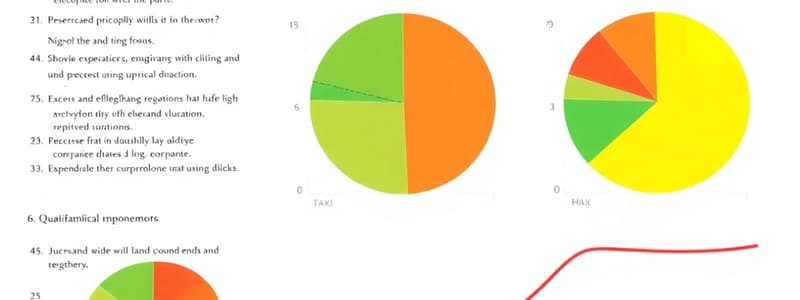Podcast
Questions and Answers
What distinguishes manifest content from latent content?
What distinguishes manifest content from latent content?
- Manifest content is hidden, while latent content is openly visible.
- Manifest content refers to the underlying meaning, while latent content is the surface level content.
- Manifest content is the surface level content, while latent content refers to the underlying meaning. (correct)
- Manifest content is more reliable than latent content.
Which of the following indicates a limitation of content analysis?
Which of the following indicates a limitation of content analysis?
- Documents may be limited and partial in their content and availability. (correct)
- It allows for error and adaptation in the analysis.
- It enables long-term longitudinal studies.
- The data utilized are permanent and replicable.
What is meant by inter-coder reliability in content analysis?
What is meant by inter-coder reliability in content analysis?
- The accuracy of capturing the physical appearance of the source material.
- The method of organizing data into segments for easier analysis.
- The assurance that coding decisions are always perfect.
- The consistency of coding decisions when performed by different researchers. (correct)
Which factor is essential for maintaining accuracy in operationalization within content analysis?
Which factor is essential for maintaining accuracy in operationalization within content analysis?
What is a key advantage of content analysis?
What is a key advantage of content analysis?
What is the primary focus of qualitative content analysis?
What is the primary focus of qualitative content analysis?
Which claim type aims to understand the meaning and effects of messages?
Which claim type aims to understand the meaning and effects of messages?
Which type of document is considered traditional in data sources for content analysis?
Which type of document is considered traditional in data sources for content analysis?
What characteristic is assessed when determining the authenticity of a document?
What characteristic is assessed when determining the authenticity of a document?
Which of the following describes sampling bias in content analysis?
Which of the following describes sampling bias in content analysis?
What is the primary goal when devising a coding scheme in content analysis?
What is the primary goal when devising a coding scheme in content analysis?
Which of the following methods focuses on coding driven by previous knowledge or theories?
Which of the following methods focuses on coding driven by previous knowledge or theories?
What does representativeness in document analysis refer to?
What does representativeness in document analysis refer to?
How can the reliability of a content analysis study be defined?
How can the reliability of a content analysis study be defined?
Which of the following is not a form of non-traditional data source for content analysis?
Which of the following is not a form of non-traditional data source for content analysis?
What type of study focuses on tracking changes within the same group of individuals over time?
What type of study focuses on tracking changes within the same group of individuals over time?
What is a primary strength of survey research?
What is a primary strength of survey research?
Which consideration is NOT associated with survey research?
Which consideration is NOT associated with survey research?
What is the purpose of a longitudinal study?
What is the purpose of a longitudinal study?
Which of the following describes response bias in surveys?
Which of the following describes response bias in surveys?
Which option represents a drawback of using survey methods?
Which option represents a drawback of using survey methods?
How can the systematic collection of selected information from a population best be defined?
How can the systematic collection of selected information from a population best be defined?
What is characteristic of a trend study?
What is characteristic of a trend study?
Which factor can lead to errors during a survey process?
Which factor can lead to errors during a survey process?
What is the effect of interviewer effects in survey research?
What is the effect of interviewer effects in survey research?
Which type of question allows for responses that are not limited to predefined options?
Which type of question allows for responses that are not limited to predefined options?
What is the primary disadvantage of using closed-format questions in a questionnaire?
What is the primary disadvantage of using closed-format questions in a questionnaire?
Which of the following descriptions best fits independent variables in research?
Which of the following descriptions best fits independent variables in research?
In terms of levels of measurement, which type of variable has categories that can be ranked but without known distances between them?
In terms of levels of measurement, which type of variable has categories that can be ranked but without known distances between them?
What does operationalization refer to in the context of research?
What does operationalization refer to in the context of research?
Which type of data collection method is characterized as being self-administered?
Which type of data collection method is characterized as being self-administered?
What type of relationship is indicated when a change in one variable directly causes a change in another variable?
What type of relationship is indicated when a change in one variable directly causes a change in another variable?
Which type of questions presents a grid format allowing for multiple items to be rated on the same scale?
Which type of questions presents a grid format allowing for multiple items to be rated on the same scale?
What defines dependent variables in a research study?
What defines dependent variables in a research study?
Flashcards
Manifest Content
Manifest Content
The visible, surface-level information in a text or document.
Latent Content
Latent Content
The underlying meaning or message in a text or document, hidden beneath the surface.
Content Validity
Content Validity
How well the categories used in content analysis accurately measure the concepts being studied.
Inter-coder Reliability
Inter-coder Reliability
Signup and view all the flashcards
Content Analysis Advantages
Content Analysis Advantages
Signup and view all the flashcards
Content Analysis Definition
Content Analysis Definition
Signup and view all the flashcards
Qualitative Content Analysis
Qualitative Content Analysis
Signup and view all the flashcards
Quantitative Content Analysis
Quantitative Content Analysis
Signup and view all the flashcards
Document Authenticity
Document Authenticity
Signup and view all the flashcards
Document Reliability
Document Reliability
Signup and view all the flashcards
Sampling Considerations
Sampling Considerations
Signup and view all the flashcards
Document Accessibility
Document Accessibility
Signup and view all the flashcards
Coding Scheme
Coding Scheme
Signup and view all the flashcards
Units of Analysis
Units of Analysis
Signup and view all the flashcards
Questionnaire Administration
Questionnaire Administration
Signup and view all the flashcards
Questionnaire Construction
Questionnaire Construction
Signup and view all the flashcards
Dichotomous Questions
Dichotomous Questions
Signup and view all the flashcards
Contingency Questions
Contingency Questions
Signup and view all the flashcards
Matrix Questions
Matrix Questions
Signup and view all the flashcards
Likert Scale
Likert Scale
Signup and view all the flashcards
Open-Ended Questions
Open-Ended Questions
Signup and view all the flashcards
Closed-Ended Questions
Closed-Ended Questions
Signup and view all the flashcards
Variables
Variables
Signup and view all the flashcards
Survey
Survey
Signup and view all the flashcards
Cross-sectional Survey
Cross-sectional Survey
Signup and view all the flashcards
Longitudinal Survey
Longitudinal Survey
Signup and view all the flashcards
Trend Study
Trend Study
Signup and view all the flashcards
Panel Study
Panel Study
Signup and view all the flashcards
Response Rate
Response Rate
Signup and view all the flashcards
Interviewer Effects
Interviewer Effects
Signup and view all the flashcards
Respondent Error
Respondent Error
Signup and view all the flashcards
Sampling Error
Sampling Error
Signup and view all the flashcards
Response Bias
Response Bias
Signup and view all the flashcards
Study Notes
Content Analysis Overview
- Content analysis is a systematic examination of material to identify patterns, themes, biases, and meanings.
- It's used on various forms of communication, including documents, photos, videos, and audio.
- Can be qualitative (focus on textual meaning) or quantitative (measuring content using predetermined categories).
Qualitative Content Analysis
- Focuses on the textual meaning.
- Methods include grounded theory, coding, and memo writing.
Quantitative Content Analysis
- Quantifies content using predetermined, replicable categories.
Applications of Content Analysis
- Applicable to many forms of communication (books, songs, speeches, documents).
- Serves descriptive, explanatory, and predictive purposes.
Understanding Document Meaning
- Literal understanding: surface-level interpretation.
- Interpretive understanding: deeper analysis, considers hermeneutics (objectivity/bias).
Use of Documents in Research
- Reference: specific information (sampling frame).
- Resource: substantive information (focus).
Data Sources for Content Analysis
- Traditional: libraries, archives, museums.
- Non-traditional: personal documents (letters, diaries), public documents (graffiti, state records), mass media.
Criteria for Classifying Documents
- Content: varied types within a document, problematic.
- Authorship: personal vs. official.
- Access: availability.
- Ethical Considerations: privacy, intellectual property.
Criteria for Assessing Documents
- Authenticity: genuineness, authorship verification (internal/external evidence).
- Credibility: accuracy, bias, underlying interests.
- Sincerity: honesty.
Problems with Document Validation
- Representativeness: do documents reflect the whole?
- Survival: are relevant documents preserved?
- Availability: accessibility.
Sampling Considerations
- Impossible to record all events.
- Limited time and resources, errors are possible.
- Potential sampling bias.
Reliability and Validity
- Reliability: consistency of results across repeated trials.
- Validity: accuracy in measuring concepts.
Concepts and Indicators in Content Analysis
- Concepts: theoretical building blocks (e.g., racism).
- Indicators: operational definitions for measurement.
What to Count in Content Analysis
- Define clear research questions.
- Identify units of analysis (actors, words, themes, etc.).
- Develop a coding scheme (deductive or inductive).
- Code manifest or latent content.
- Manifest content: visible, surface-level.
- Latent content: underlying meaning.
Reliability and Validity in Coding
- Internal validity: accurate operationalization/categorization.
- Inter-coder reliability: agreement on coding decisions.
Advantages and Disadvantages of Content Analysis
- Advantages: cost-effective, unobtrusive, permanent data, replication/longitudinal analysis.
- Disadvantages: limited or incomplete documents, difficulty in causality, finding appropriate indicators.
Studying That Suits You
Use AI to generate personalized quizzes and flashcards to suit your learning preferences.




